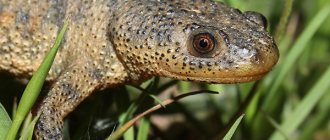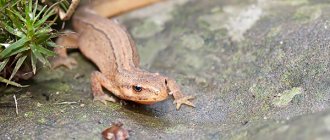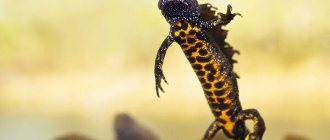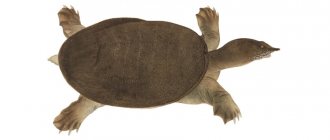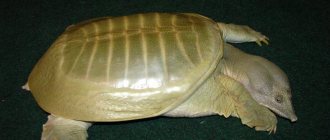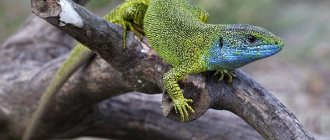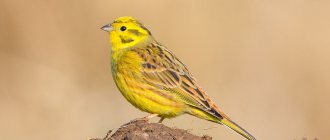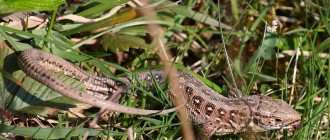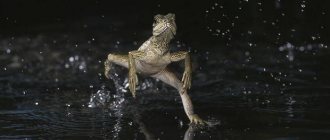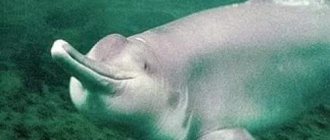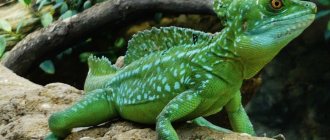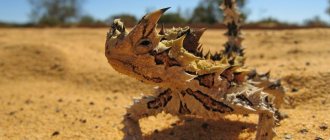Dwarf newt (Hypselotriton orientalis) among its genus it is the smallest
Dwarf newt (Hypselotriton orientalis) David, 1873.
A funny, cute amphibian with interesting behavior, which is very popular in America and Europe, and has recently attracted more and more attention from pet lovers in our country.
Family: True salamanders Genus: Hypselotriton Species: Pygmy newt
Synonyms
Triton orientalis (David, 1873) Triton pyrrhogaster orientalis (David, 1873) Diemictylus orientalis (David, 1873) Triturus orientalis (David, 1873) Cynops orientalis (David, 1873)
The fire-bellied newt is also called the Chinese red-bellied and Chinese fire-bellied, oriental and dwarf newts
. It received all these names due to its unusual coloring and tiny size. Among its genus, it is the smallest newt.
Description
The maximum body length is 10 cm. The species is distinguished by a red belly.
Appearance
The main color is dark brown to black, sometimes fading to gray. The abdomen is red or orange with black spots. There are individuals with orange dots and lines on the paws and back. The sex of the animal does not affect the color. The long tail is rounded at the end.
Behavior
The amphibian leads a terrestrial and underwater lifestyle. The preferred habitat may not change for months. The period of residence in water is accompanied by activity during daylight hours: the amphibian moves along the bottom, climbs onto plant leaves and glides down from them. On land, red-bellied fish lie motionless, at night they climb the walls of the aquarium and can even run away. The character is peaceful, sometimes aggressive towards small species.
Lifespan
In good conditions, the newt lives 10–11 years.
Interesting Facts
Regeneration significantly extends the life of newts. They are able to restore not only lost limbs, but also eyes and even internal organs.
Some newts briefly change the color of the skin on their back from dark to light shades, while the ventral side does not change color.
Moist skin is protected by a special secretion that retains moisture inside the body and prevents pathogens from penetrating the mucous membrane and infecting the animal.
Chinese aquarium newts easily get used to their owners, are able to recognize them, and are quite smart.
Kinds
Red-bellied newts form a group of newts from different genera. Red-bellied animals are capable of existing without access to land. The requirements of newts for keeping in an aquarium are largely similar.
Short-legged
The short-legged red-bellied newt grows up to 21 cm in length. The limbs are thick and short, the skin is smooth. The color is brownish-brown, the newt's eyes are small. Capable of living for a long time in water.
Firebellied
Under the guise of Japanese fire-bellied, the widespread oriental red-bellied is sold. Like the short-legged newt, the fire-bellied newt can only live in a body of water. The number of the species is declining and is listed in the Red Book. An active species, tolerant of aquarium fish.
Red-bellied
A native of the Western American newt family, it grows up to 20 cm in length. The skin is lumpy and contains poison that paralyzes the respiratory muscles. This feature prevents predators from eating the amphibian.
Rare
- Blue-tailed fire-bellied newt. Body color ranges from brown to dark. There are scarlet patches on the cheeks. During the mating season, the tail of males turns blue. In nature they lead an aquatic and terrestrial lifestyle, but in captivity they are predominantly aquatic.
- Okinawan or horseshoe crab. The newt's color is black with a reddish belly. There are individuals up to 20 cm in length. The breeding season is accompanied by the appearance of blue stripes on the tail of males. Relatively thermophilic.
- Striped newt. Almost never found in nature; populations exist in captivity. The length of amphibians is 9–12 cm. The color ranges from brown to black. There are dark spots on the red belly.
Breeding
After the animal has overwintered and adapted, the mating period begins. Newts reach sexual maturity at 3 years. Stimulation for reproduction will be aeration and raising the water temperature in the aquaterrarium to 23–24ºC.
During the mating season, the male attracts the attention of the female. This is manifested in sweeping movements of the tail, the tip of which trembles slightly. When compatible, the couple begins the process of mating and fertilization - the spermatophore released by the male is deposited in the female’s sperm duct.
Content
Chinese red-bellied newts are unpretentious pets that do not require expensive equipment. Unlike many terrarium inhabitants, these amphibians do not need an ultraviolet lamp.
Terrarium and aquarium
The size of the tank for two individuals is 20–30 liters. Select a wide rectangular container with a lid. Even the presence of a lid does not guarantee that the newt will not end up outside the aquarium: red-bellied pets can escape through the slots for wires and hoses.
Home improvement
Place an island above the water surface or a piece of driftwood sticking out of the pond in the aquaterrarium. This will serve as a decorative element and allow the amphibian to go onto land. A cooling system is required. If a special cooler is not available, install an aquarium thermometer and a computer cooler. Place bottles and ice packs in a container. Make sure that the temperature change is not sudden. Having an air conditioner in the room will simplify the task.
Water
Red-bellied amphibians are unpretentious about the hydrochemical composition of water, but are demanding about the temperature in the aquarium. Water level up to 20 cm. Do not allow chlorine to enter the container. Set aside the water before changing. Replace one third of the total volume every 10 days. Optimal parameters:
| Acidity | slightly acidic 5–7 |
| Rigidity | soft (4–8 dGh) |
| Temperature | 20–25 degrees in summer, 12–15 degrees in winter |
| Water movement | weak or absent |
Aeration
Saturation of water with oxygen is not necessary. Red-bellied amphibians breathe atmospheric air when they swim to the surface. Only young animals will need aeration until the structure of the gills changes.
Plants
Take care of shelters in the aquarium with the amphibian. Amphibians will be comfortable among dense thickets of hard-leaved plants. Plant a variety of vegetation:
- Anubias;
- cryptocrines;
- Elodea;
- mosses;
- pinnate;
- cabomba;
- arrowheads.
Priming
Place large pebbles and gravel on the bottom to prevent the newt from swallowing substrate particles. Add shelters in the form of grottoes, rocks and snags. Clean the soil with a siphon every 7–10 days.
Lighting
Red-bellied amphibians are unpretentious to lighting. When placing lamps, rely on the needs of the plants. Choose LED bulbs to provide your plants with more light with less heat output. Incandescent lamps should not be placed, they quickly heat the water. It is advisable to place an ultraviolet lamp for newts. Turn on the UV lamp daily for 2–3 hours. However, newts will feel fine without a UV lamp.
Arrangement and parameters of the aquarium
For a pair of these newts you will need a 10-15 liter aquarium, in which you should definitely arrange an island or raft made of cork or polystyrene foam, since these amphibians love to go out onto land to dry off and rest. You can use a mound of stones protruding from the water for this. The aquarium is covered with a lid to prevent newts from escaping.
For a comfortable existence, a large number of different plants are required, for example: anubias, salvinia, watercolor, cryptocorynes, echinodorus, elodea, pinnate.
The soil used is gravel or coconut substrate, the size of which is larger than the size of the newt's mouth.
Pea gravel can be swallowed, which is life-threatening. It is desirable to have different shelters and snags, both in the underwater and above-water parts of the aquarium.
It is necessary to ensure low water temperature, no more than 20-22°C in summer and 12-15°C in winter.
Newts can hardly tolerate an increase in temperature, experiencing severe discomfort. The water is soft, slightly acidic. Water changes should be carried out approximately once every 3 weeks, replacing no more than a third of the old water. You can only use well-settled water, as they are very sensitive to chlorine.
Newts require UV exposure at 2% UVB throughout the day, approximately 10-12 hours. Such lamps combine two functions - irradiation and lighting.
In nature, they live in low-flowing waters, so powerful filters cannot be used, but a little filtration and aeration are still necessary.
Feeding
Red-bellied amphibians in nature feed on small invertebrates. But poorly processed live food can introduce parasites into the aquarium. The best option would be to make homemade frozen food. You will know the storage conditions and quality. Re-freezing is not allowed. The feeding schedule of young and adult newts differs: feed young ones daily, adults - once every 2-3 days.
The basis of the diet is live food:
- bloodworm;
- tubifex;
- earthworms;
- Artemia (artemia salina);
- daphnia;
- seafood;
- fish fry;
- live gammarus;
- Cyclops.
Serve crushed eggshells as a source of calcium. Add vitamins. If desired, diversify your diet with dry food. Food for newts is suitable for turtles and frogs. Feed the amphibians until they are full.
Reproduction
After wintering, the temperature in the aquarium is raised to 24°C, aeration is turned on, and the newts begin to reproduce. Their fertilization is internal: the male lays a spermatophore, which the female draws in with her cloaca, and then, after 2-3 days, spawns up to 300 eggs, attaching them to plants. If there are no living plants in the aquarium with newts, small strips of polyethylene can be placed there as a substrate for eggs.
The clutch must be removed to another aquarium or the adult newts must be removed, otherwise they may eat the eggs or larvae. After a day or two, the dead eggs are removed, leaving only those eggs that remain transparent, and the embryos in them have turned from balls into something like commas.
Some time after laying eggs, newts usually molt and eat their old skin, and then often enter another land phase.
The larvae hatch in 2-4 weeks. At first they are very small, resembling thin lines with a prominent head; in a general aquarium with soil and plants they are practically invisible. Only when worried do they scatter to the sides like specks.
They are fed live dust - ciliates, rotifers, Artemia nauplii. If there are few larvae and they live in the main aquarium with a stable biological balance and living plants, there are plenty of small food organisms there. You can additionally place several ampularia snails with the larvae, the mucus of which promotes the reproduction of ciliates.
When the larvae are kept in a special nursery aquarium, they are fed several times a day with Artemia nauplii or specially grown ciliates. As the larvae grow, they switch to feeding on larger animals, preferably daphnia. In the future, you can start feeding them chopped tubifex and small bloodworms, but this must be done carefully, since there is a great danger of introducing parasites or infection with this food.
It is much safer to give babies home-grown daphnia right up to metamorphosis, and then try to immediately switch to feeding shrimp fibers with tweezers. It is ideal if it is possible to feed newts with home-bred Aulophorus or Enchytraea worms, as well as fry of aquarium fish or juvenile freshwater shrimp.
Newt larvae and juveniles do not require special conditions for keeping them; all they need is aeration, regular cleaning of the aquarium, and a temperature of about 22°C.
Due to the branched external gills on the sides of the head and large mouth, the grown larvae are very funny, they resemble small smiling tailed Cheburashkas. The color of the babies is usually dark gray or brownish, the abdomen is paler.
Metamorphosis of the larvae - the loss of external gills and a change in the structure of the skin - occurs gradually at the age of two to four months, at which time they are 3-4 cm long. The larvae begin to emerge and swallow air from the surface of the water. At this point, they need to be provided with the opportunity to go to land, that is, place an island in the aquarium that would be easy to get out to.
Sometimes after metamorphosis, young newts may refuse food for several days. Further, they are cared for in the same way as for adults. They can be placed in a common aquarium with their parents as soon as they grow so large that adult newts cannot swallow them. Young newts usually enter the aquatic phase 2-3 months after metamorphosis. Dwarf newts reach sexual maturity at the age of 1-3 years.
Compatibility
A species aquaterrarium is the best option. The following cannot be placed in the same container with amphibians:
- small fish and snails;
- too large predatory fish;
- crayfish;
- crabs;
- large newts;
- clawed frogs.
Red-bellies are compatible with the following neighbors:
- large shrimp;
- peaceful frogs;
- corridors;
- gourami;
- iris;
- other peaceful, medium-sized fish.
Where does it live?
The habitat of newts extends to Europe, Asia, North and South America. Most species live in temperate climates.
VARAN
Where live
The newt's natural habitat is shallow freshwater bodies of water and the surrounding area with rich vegetation. They avoid meadows, fields and other open areas. Some species are found in mountain streams and lakes located at altitudes of up to 2000 meters above sea level.
Wintering
As temperatures drop in late autumn, amphibians hibernate. Two weeks before wintering, gradually lower the temperature to 15 degrees and reduce daylight hours. Move the newts to a sphagnum moss cage in an area of identical temperature. After 3 days, place the cage with amphibians in the refrigerator. After 2 months, bring the animal out of hibernation by gradually increasing the temperature and gradually extending daylight hours.
At home, red-bellies can do without hibernation. But observing seasonal rhythms is useful, especially if you need to stimulate the reproduction of newts.
Diseases
Red-bellied amphibians have good health and the ability to regrow lost limbs. Rehabilitate quickly after treatment. Causes of diseases:
- lack of necessary aquarium hygiene;
- poor diet;
- unprocessed live food or aquarium elements;
- other sick animals;
- injuries;
- stress from the wrong neighborhood.
It is difficult to determine a specific disease. If a newt is sick, it is often affected by several diseases at once. An animal's disease is indicated by:
- decreased appetite;
- long stay on land;
- lethargy;
- lack of coordination;
- sores or plaque on the skin;
- blurred eyes.
Determine the cause of the illness and improve living conditions. Pay close attention to your pet's behavior: sometimes numerous attempts to escape from the aquarium are caused by the lack of necessary conditions. Remove sick individuals. Treat newts with a combination of antiprotozoal, antimicrobial, and antifungal medications. For 10 liters of water, take a tablet of nystatin and ciprofloxacin or trichopolum, dissolve in a glass of water and pour into the tank.
Reviews
Aquarists say Chinese red-bellied newts are very interesting to watch. Caring owners share their experience, noting that there is a lot of conflicting information about the optimal water parameters for a pet. The inhabitants of the forums agree that temperatures above 24 degrees are undesirable for newts.
Sexual dimorphism
There are no special differences between females and males, except for size. Females are slightly larger, approximately 2 cm; males have a shorter tail, but a better developed fin. The female's tail is either equal to or longer than the body length. During breeding, the cloaca thickens in males.
The Chinese newt reaches sexual maturity 3 years after completion of metamorphosis.
